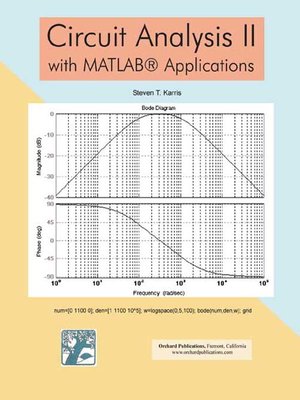
Sign up to save your library
With an OverDrive account, you can save your favorite libraries for at-a-glance information about availability. Find out more about OverDrive accounts.
Find this title in Libby, the library reading app by OverDrive.



Search for a digital library with this title
Title found at these libraries:
| Library Name | Distance |
|---|---|
| Loading... |
This text is written for use in a second course in circuit analysis. The reader of this book should have the traditional undergraduate knowledge of an introductory circuit analysis material such as Circuit Analysis I with MATLAB® Applications by this author. Another prerequisite would be knowledge of differential equations, and in most cases, engineering students at this level have taken all required mathematics courses. It encompasses a spectrum of subjects ranging from the most abstract to the most practical, and the material can be covered in one semester or two quarters. Appendix B serves as a review of differential equations with emphasis on engineering related topics and it is recommended for readers who may need a review of this subject.
This book was written to fit the needs of the average student. Moreover, it is not restricted to computer oriented circuit analysis. While it is true that there is a great demand for electrical and computer engineers, especially in the internet field, the demand also exists for power engineers to work in electric utility companies, and facility engineers to work in the industrial areas.
Chapter 1 is an introduction to second order circuits and it is essentially a sequel to first order circuits that were discussed in the last chapter of as Circuit Analysis I with MATLAB® Applications. Chapter 2 is devoted to resonance, and Chapter 3 presents practical methods of expressing signals in terms of the elementary functions, i.e., unit step, unit ramp, and unit impulse functions. Thus, any signal can be represented in the compex frequency domain using the Laplace transformation.
Chapters 4 and 5 are introductions to the unilateral Laplace transform and Inverse Laplace transform respectively, while Chapter 6 presents several examples of analyzing electric circuits using Laplace transformation methods. Chapter 7 begins with the frequency response concept and Bode magnitude and frequency plots. Chapter 8 is devoted to transformers with an introduction to self and mutual inductances. Chapter 9 is an introduction to one- and two-terminal devices and presents several practical examples. Chapter 10 is an introduction to three-phase circuits.
It is not necessary that the reader has previous knowledge of MATLAB®. The material of this text can be learned without MATLAB. However, this author highly recommends that the reader studies this material in conjunction with the inexpensive MATLAB Student Version package that is available at most college and university bookstores. Appendix A of this text provides a practical introduction to MATLAB. As shown on the front cover of this text the magnitude and phase plots can be easily obtained with a one line MATLAB code. Moreover, MATLAB will be invaluable in later studies such as the design of analog and digital filters.
As stated above, Appendix B is a review of differential equations. Appendix C is an introduction to matrices, Appendix D provides instructions on constructing semilog templates to be used with Bode plots, and Appendix E discusses scaling methods.
In addition to numerous examples, this text contains several exercises at the end of each chapter. Detailed solutions of all exercises are provided at the end of each chapter. The rationale is to encourage the reader to solve all exercises and check his effort for correct solutions and appropriate steps in obtaining the correct solution. And since this text was written to serve as a self-study or supplementary textbook, it provides the reader with a resource to test his knowledge.







